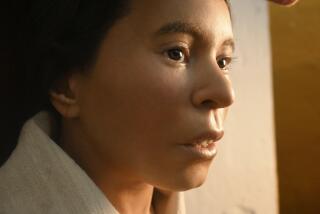Frozen Body of Inca Girl to Go on Display
WASHINGTON — The frozen body of a girl sacrificed 500 years ago by the Incas of Peru will go on display in Washington on May 21 despite objections from Peruvian scholars, the National Geographic Society said Wednesday.
“The Peruvian government has been very cooperative,” said Barbara Moffet, spokeswoman for the society, which is sponsoring the exhibit. “We expect to have a high-level visitor from Lima for the opening.”
Some Peruvian scholars have objected that transporting the body of the girl, who was about 13 when she died, might be risky and that it should be examined in Peru rather than abroad.
Moffet said U.S. air-conditioning experts have designed two cases specially for the mummy to keep it frozen, one for air transport from Peru and another for its display in Washington. The display room will be kept at normal temperature for viewers.
She said the Incas had a practice of taking children to a mountaintop at times of crisis and sacrificing them, probably to please their gods. Johan Reinhard, an American archeologist, found the girl at 20,000 feet near the top of Mt. Ampato in the Andes last October.
She must have frozen almost instantly, Moffet said. The body was clothed in elaborate textiles and surrounded by ritual pots and other objects.
The archeologists named her “Juanita,” born probably in the late 15th century or early 16th century--sometime during that 90 years that the Incas ruled Peru before the Spanish conquest of 1532-33, Moffet said.
Reinhard said when “Juanita” was discovered, frozen Inca mummies had never been found before, and the remains could contain 500-year-old living organisms that would allow scientists to make a major leap in understanding the Incas.
Two bodies of children found nearby had been hit by lightning and only the skeletons remain, Moffet said.
“Juanita” will leave in a few days for Baltimore, where researchers will examine her with advanced equipment. From there she will go to Washington for the exhibit.
She will be on display at the National Geographic Society until June 19.
More to Read
Sign up for Essential California
The most important California stories and recommendations in your inbox every morning.
You may occasionally receive promotional content from the Los Angeles Times.










